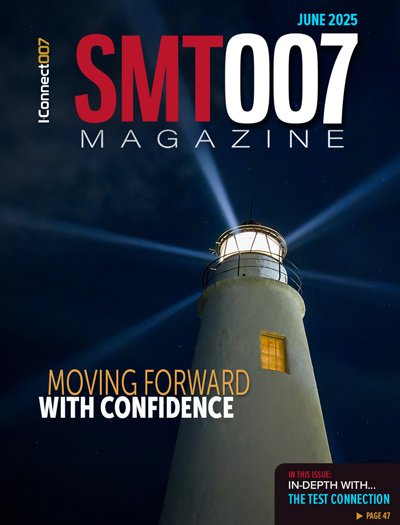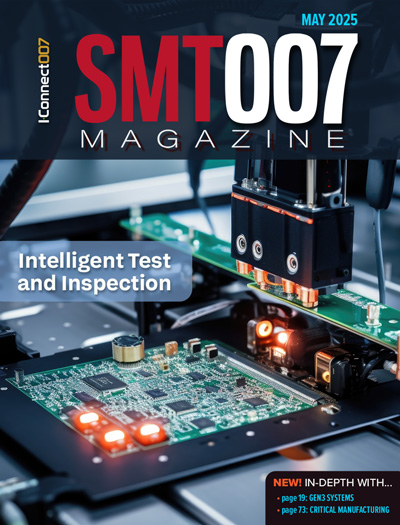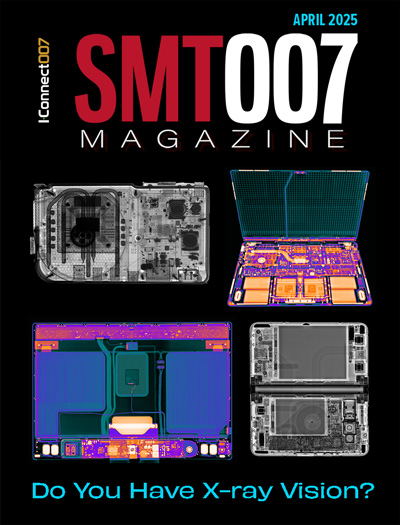-

- News
- Books
Featured Books
- smt007 Magazine
Latest Issues
Current Issue
Moving Forward With Confidence
In this issue, we focus on sales and quoting, workforce training, new IPC leadership in the U.S. and Canada, the effects of tariffs, CFX standards, and much more—all designed to provide perspective as you move through the cloud bank of today's shifting economic market.

Intelligent Test and Inspection
Are you ready to explore the cutting-edge advancements shaping the electronics manufacturing industry? The May 2025 issue of SMT007 Magazine is packed with insights, innovations, and expert perspectives that you won’t want to miss.

Do You Have X-ray Vision?
Has X-ray’s time finally come in electronics manufacturing? Join us in this issue of SMT007 Magazine, where we answer this question and others to bring more efficiency to your bottom line.
- Articles
- Columns
- Links
- Media kit
||| MENU - smt007 Magazine
DARPA Kicks Off JUMP 2.0 Consortium Aimed at Microelectronics Revolution
January 4, 2023 | DARPAEstimated reading time: 2 minutes
DARPA, along with the Semiconductor Research Corporation (SRC) and industry and academic stakeholders, is kicking off the Joint University Microelectronics Program 2.0 (JUMP 2.0). The SRC-led effort expands on the original JUMP collaboration aimed at accelerating U.S. advances in information and communications technologies.
The consortium created under JUMP 2.0 will pursue high-risk, high-payoff research spanning seven thematically structured centers. Each multidisciplinary center will focus on one overarching research theme identified as key to addressing emerging technical challenges. These defined interests, spurred by an increasingly connected world and a rapidly changing microelectronics landscape, will centralize long-term, pathfinding research aimed at breakthroughs applicable across defense and academia.
“JUMP 2.0 builds on a 25-year history of partnership between DARPA, SRC, and industry investing in university research focused on disruptive microelectronics,” said Dev Palmer, deputy director of the Microsystems Technology Office (MTO) and the agency’s lead for JUMP 2.0. “This public-private collaboration enables DARPA to incorporate diverse perspectives to drive research thrusts and leap-ahead advances that help keep the U.S. at the forefront of microelectronics.”
As a critical part of the DARPA Electronics Resurgence Initiative, JUMP 2.0 seeks to significantly improve performance, efficiency, and capabilities across a range of electronics systems. Novel materials, devices, architectures, algorithms, designs, integration techniques, and other innovations are at the heart of problem-solving for next-generation information and communications challenges. To that end, the centers will focus on JUMP 2.0’s seven complementary research themes, led by the following university-run centers:
- Cognition: Next-generation AI systems and architectures (Center for the Co-Design of Cognitive Systems, Georgia Institute of Technology)
- Communications and Connectivity: Efficient communication technologies for ICT systems (Center for Ubiquitous Connectivity, Columbia University)
- Intelligent Sensing to Action: Sensing capabilities and embedded intelligence to enable fast and efficient generation of actions (Center on Cognitive Multispectral Sensors, Georgia Institute of Technology)
- Systems and Architectures for Distributed Compute: Distributed computing systems and architectures in an energy efficient compute and accelerator fabric (Evolvable Computing for Next Generation Distributed Computer Systems, University of Illinois Urbana-Champaign)
- Intelligent Memory and Storage: Emerging memory devices and storage arrays for intelligent memory systems (Center for Processing with Intelligent Storage and Memory, University of California San Diego)
- Advanced Monolithic and Heterogenous Integration: Novel electric and photonic interconnect fabrics and advanced packaging (Center for Heterogeneous Integration of Micro Electronic Systems, Penn State)
- High-Performance Energy Efficient Devices: Novel materials, devices, and interconnect technologies to enable next-generation digital and analog applications (SUPeRior Energy-efficient Materials and dEvices or SUPREME, Cornell University)
Suggested Items
IBM, RIKEN Unveil First IBM Quantum System Two Outside of the U.S.
06/24/2025 | IBMIBM and RIKEN, a national research laboratory in Japan, today unveiled the first IBM Quantum System Two ever to be deployed outside of the United States and beyond an IBM Quantum Data Center.
Zero Defects International Partner, Epoch International, Announces Sale on Precision Control Systems
06/21/2025 | Zero Defects InternationalZero Defects International partner, EPOCH INTERNATIONAL, has announced significantly reduced overstock pricing for a large quantity of precision industrial motor, actuator, and sensor control systems.
INVISIO Secures SEK 145 Million Order for Dismounted Soldier Systems
06/21/2025 | INVISIOINVISIO has received a significant order from a new European customer for its dismounted soldier systems. Deliveries are to be completed during 2025.
MRSI Systems, LLC Files Patent Infringement Lawsuit Against Suzhou LieQi in China
06/16/2025 | MRSI Systems, LLCMRSI Systems, LLC (a part of Mycronic Group), a global high-tech company that provides high precision production solution in electronics industry, filed a patent infringement lawsuit against Suzhou LieQi Intelligent Equipment Co., Ltd. (SZLQ) with Shenzhen Intermediate People’s Court for infringement of MRSI Systems’ patent related to die bonder (Case No. (2025) YUE03minchu No. 7154).
UK Commits £204.6m to Typhoon’s Future Radar
06/16/2025 | BAE SystemsThe UK Government has released £204.6m of funding towards the production and integration of an advanced new radar for the latest Royal Air Force (RAF)’s Eurofighter Typhoon jets.


